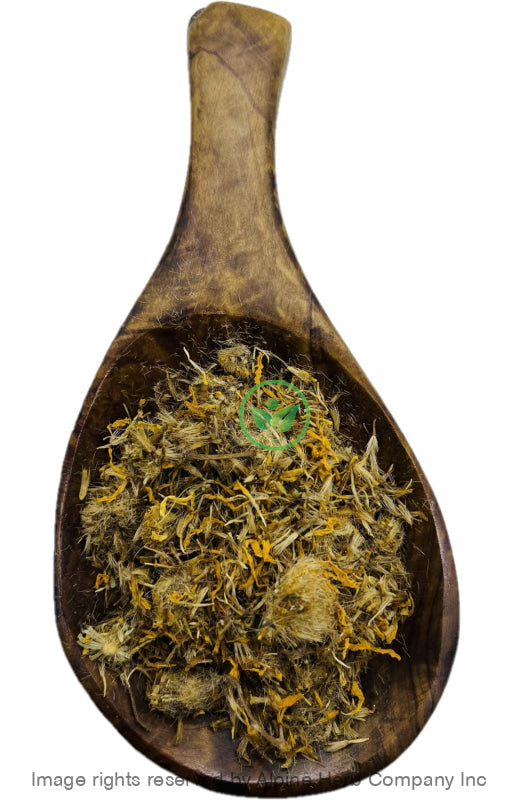Arnica Flower Whole (Romania) Alpine Herb Company Inc.
$ 56,99 $ 28,50
Botanical Name: Arnica montana
Common Name:
- English: European Arnica
- aka: Leopard’s Bane, Wolf’s Bane, Arnica, Aronique, Polmonaria di Montagna, Mountain Tobacco, American Arnica, Arctic Arnica, Arnica angustifolia, Arnica chamissonis, Arnica cordifolia, Arnica des Montagnes, Arnica Flos, Arnica Flower, Arnica fulgens, Arnica latifolia, Arnica montana, Arnica sororia, Arnikablüten, Bergwohlverleih, Doronic d’Allemagne, European Arnica, Fleurs d’Arnica, Foothill Arnica, Heart-Leaf Arnica, Herbe aux Chutes, Herbe aux Prêcheurs, Hillside Arnica, Kraftwurz, Leopard’s Bane, Mountain Arnica, Mountain Snuff, Mountain Tobacco, North American Meadow Arnica, Plantin des Alpes, Quinquina des Pauvres, Souci des Alpes, Tabac des Savoyards, Tabac des Vosges, Twin Arnica, Wolf’s Bane, Wolfsbane, Wundkraut.
Origin: Romania
Harvested: Wild
Parts Used: Flowers
General Information:
Arnica montana is one of the most beneficial substances available in nature’s pharmacopeia.
Arnica is an herb that grows mainly in Siberia and central Europe, as well as temperate climates in North America. The flowers of the plant are used in medicine.
This plant has very similar uses to those of Heterotheca inuloides (Mexican Arnica), which is the species more commonly used in Mexico. Both Romania (European) and Mexican arnica belong to the daisy or sunflower family, although their active principles are not all the same.
Due to toxicity, Arnica flower should only be used externally.
Arnica is an essential for every herbal first aid kit, especially for the active individual, sports enthusiast, or weekend warrior. You should not use arnica on broken skin. This is because the flower has toxic effects. Just as you should not take it internally, you shouldn’t expose it to areas where it can meet your bloodstream. Carefully inspect any area of the skin before you apply arnica flower or cream to it to make sure that there’s no broken skin. It can be helpful in healing a wound more quickly so you can get back on your feet and back to your life more quickly and with less pain
Precautions:
Any species of Arnica (including this one and or similar, such as for example Heterotheca inuloides ) should not be taken internally, due to their potential toxicity, especially by small children, and patients suffering from heart disease.
DO NOT ingesting any herbal product or supplement that contains arnica during pregnancy and lactation.
Discontinue any external application of arnica products at the first sign of inflammation or skin irritation.
Arnica preparations may cause allergic reactions, especially in people sensitive to other plants belonging to the daisy family, such as ragweed and feverfew, for example.
Do not use arnica products for prolonged treatments.
You should consult with a qualified healthcare practitioner before using any herbal products, particularly if you are pregnant, nursing, or on any medications.
All information on this website is for educational purpose ONLY
This information has not been evaluated by Health Canada.
This information is not intended to diagnose, treat, cure, or prevent any disease.
Avoid self-diagnosis and self-medication: Always be on the safe side!
| Unit Size | 100g, 200g, 400g, 1kg |
|---|
Prompt shipping and expert packing
Thanks to our longstanding association with UPS FedEx DHL as well as other leading global carriers, we can offer a variety shipping options. Our warehouse staff is highly trained and will be able to pack your goods in accordance with our precise and exact specifications. Your items will go through an exhaustive examination before they will be securely packaged before being delivered. We ship to hundreds of thousands of customers daily in different countries. This is a sign of our determination to become the largest online retailer worldwide. Warehouses and distribution centers are located throughout Europe as well as in the USA.
Note that orders containing multiple items are processed according to the particular item.
We will thoroughly inspect all items ordered before shipping. Most orders are shipped within 48 hours. The delivery time will be between 3 and 7 working days.
Returns
The stock market is always changing. It's not entirely managed by us since we're involved with several entities, including the factory and the storage. Therefore, the actual inventory could fluctuate at any moment. Please be aware that it is possible that your order could be out of stock after you've placed your order.
Our policy lasts for 30 days. If it's been more than 30 days since the date you purchased your item We're sorry to say that we can't offer you a full exchange or refund.
You can only return a product if it is unused and still in the same state as when you received it. The item should be in the original packaging.
Related products
Herb Whole
Herb Whole
Herb Whole
Herb Whole
Herb Whole
Herb Whole
Herb Whole
Herb Whole
Herb Whole
Herb Whole
Herb Whole
Herb Whole
Herb Whole
Herb Whole
Herb Whole
Herb Whole



































